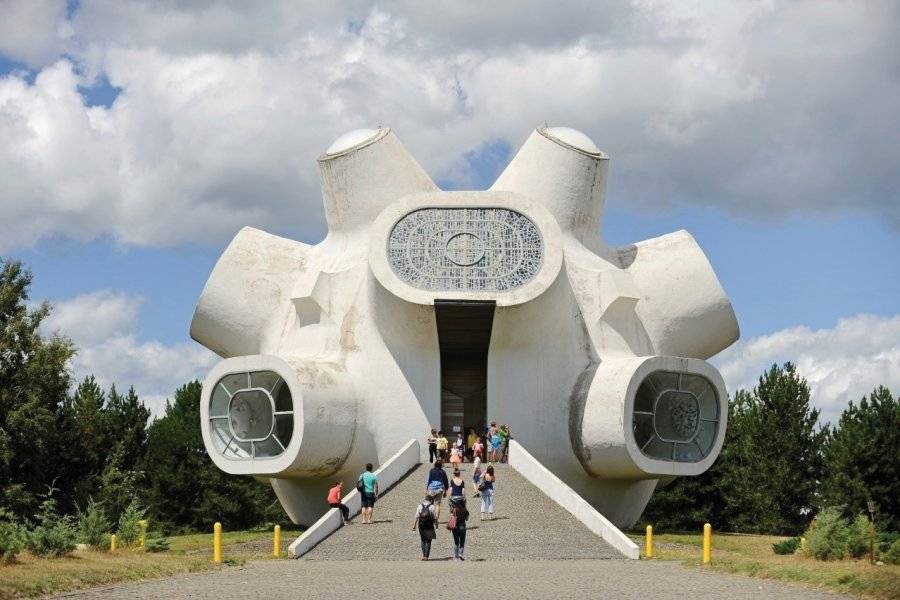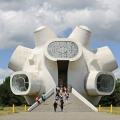MAKEDONIUM
This 12-hectare memorial complex (Македониум) houses one of the most beautiful monuments inherited from socialist Yugoslavia: a futuristic "dome" often compared to a spaceship. Commemorating the Ilinden Uprising of August 2, 1903, it dominates Kruševo at an altitude of 1,320 m. The Makedonium, also known as the Ilinden Monument (Споменик Илинден/Spomenik Ilinden), was inaugurated on August 2, 1974. It is the major work of sculptor Jordan Grabulovski (1925-1986). He collaborated with his wife, architect Iskra Grabulovski (1936-2008), and painters Borko Lazeski (1917-1993) for the stained-glass windows and Petar Mazev (1927-1993) for the mosaics. The country's most renowned artist, Jordan Grabulovski - known in the West as Jordan Grabul - helped create the modern sculptural movement in Yugoslavia in the 1950s. Makedonium is his most accomplished project. His style is resolutely "optimistic", with the sculpture forming a whole with its functional environment.
The path. Conceived as a pathway, the complex offers a magnificent panorama of Kruševo and the surrounding area. The entrance is marked by the Chains monument (Пранги/Prangi): five concrete arches painted white, representing the five centuries of Ottoman "oppression". Two of them are open, forming the letter "С" of the word Слобода/Sloboda ("freedom"). A 100 m-long paved path then climbs up to the Crypt monument (Криптата/Cryptata). This is a circular esplanade surrounded by white walls. These bear 58 cones on which are inscribed the names of revolutionaries, intellectuals, fighting units and locations of the various insurrectionary movements of the 19th and 20th centuries. These include the name of Nozhot/Ножот, a village in the Prilep region where a battle took place in 1907, or that of revolutionary Dimitar Vlahov (1878-1953). The path continues to climb for around 100 m to theAmphitheater (Амфитеатар/Amfiteatar). Located in line with the dome, this space is composed of two concentric circles. The outer circle is decorated with colorful mosaics forming eight geometric figures that represent the different motifs of traditional carpets from the country's regions. The inner circle houses an alignment of 270 white studs, each 30 cm high. The significance of this installation is little-known today: the staff on site evoke both the representation of the molecular composition of water and that of the symbol of revolutionaries who died in battle. The path continues for 50 m to the ramp that leads to the entrance to the dome.
The Dome. This Dome (Купола/Cupola) is the major feature of the complex. It's a white concrete sphere 34 m in diameter and 12.5 m high, spiked with twelve excrescences pierced with openings. The wooden entrance door is embellished with the letter M for "Makedonia". Inside, the single circular room, immaculate and bathed in soft natural light, houses the tomb of Nikola Karev (1877-1905). This is adorned with a polished white marble cube resting on a corner, one edge of which is hollowed out to symbolize the unfinished life of the leader of the 1903 insurrection. The four side openings, pointing towards the cardinal points, feature large bay windows. Their walls are decorated with white figurative sculptures representing, from left to right, the four major stages in the country's creation: the Ottoman invasion (1392), the Ilinden uprising and the division of Macedonia after the Balkan wars (1912-1913), the war of national liberation (1941-1945), freedom and unity (1945). The four openings in between feature colorful stained-glass windows evoking the seasons and the different components of the Macedonian people. The last series of openings, at the top, is made up of skylights, some of whose conical shape is reminiscent of the wooden cannons built by the Kruševo insurgents in 1903. Finally, in the center of the room is the Eternal Flame: a block originally in polished white marble (now in plastic), representing a Macedonian sun with 16 rays. These concentrate into eight rays to attract the "cosmic energy" represented by a faint orange light in the center, symbolizing both fire and a beating heart. Because of its shape, the building has a special acoustic feature. The designers wanted to take advantage of this by asking composer Toma Prošev (1931-1996) to write a work especially for the site. This is the oratorio Sonce na prastarata zemja ("Sun of the Ancient Land"), which is rarely broadcast to visitors.
The memorial today. Every year on August 2, the Makedonium is the setting for the great national celebration commemorating the 1903 uprising. Although it also features on 10,000-denar banknotes, it is no longer held in high esteem by the authorities, who criticize it for its Yugoslav past. With its futuristic form evoking molecular structures, the Makedonium is nevertheless a masterpiece in its refusal of figuration. It remains particularly moving in that it does not seek to use images of war and death, but to convey the idea of the spirit of resistance and life that animated the heroes of Ilinden. It's a monument of hope, marking the beginning of a new society that was once thought to be ideal.
Did you know? This review was written by our professional authors.
Members' reviews on MAKEDONIUM
The ratings and reviews below reflect the subjective opinions of members and not the opinion of The Little Witty.




